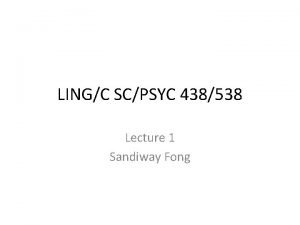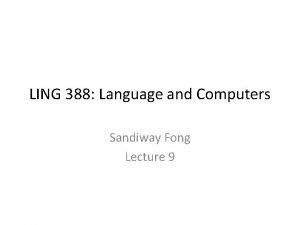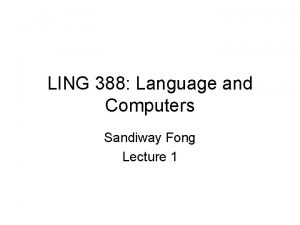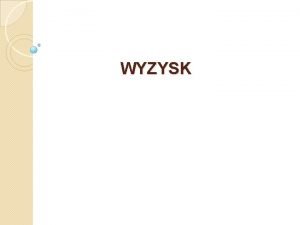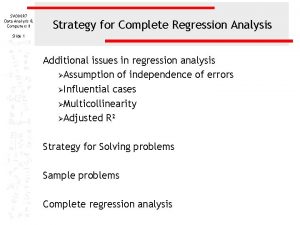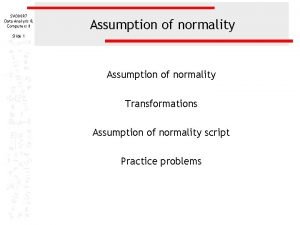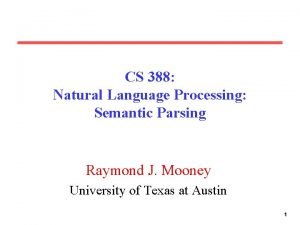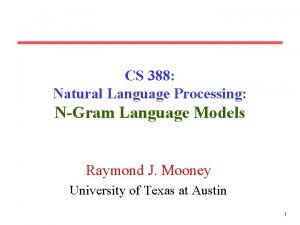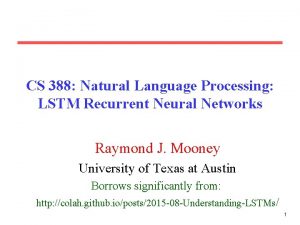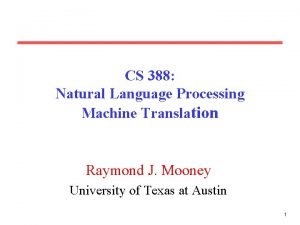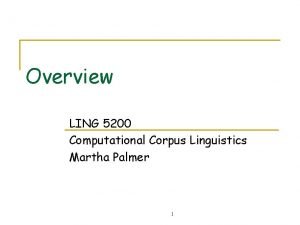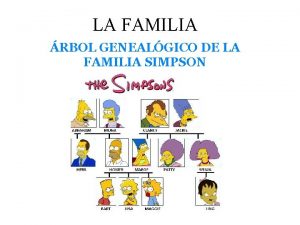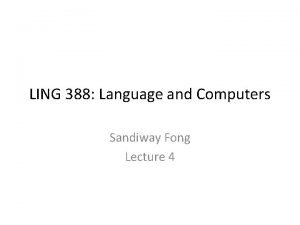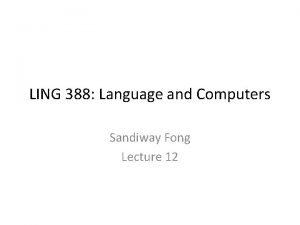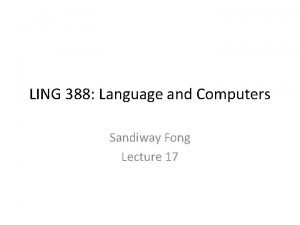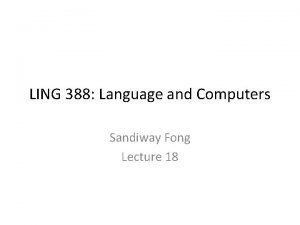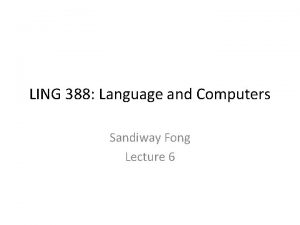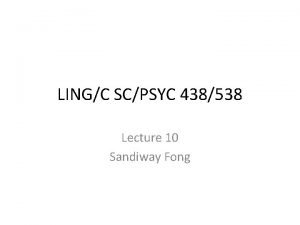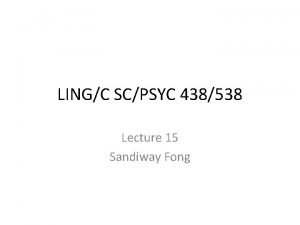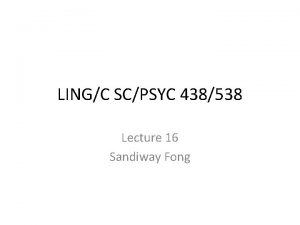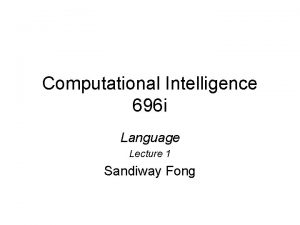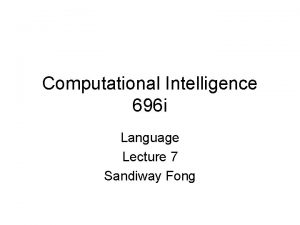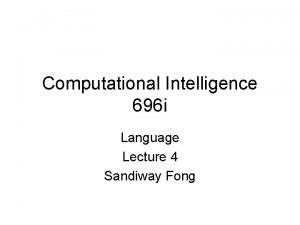LING 388 Language and Computers Sandiway Fong Lecture
































- Slides: 32

LING 388: Language and Computers Sandiway Fong Lecture 22

Review of g 21. pl • g 21. pl is the latest English grammar we've developed so far …

g 21. pl

g 21. pl

g 21. pl

g 21. pl All subject NPs have a nom Case constraint

g 21. pl % am % are

g 21. pl All VP object NPs have an acc Case constraint

g 21. pl PP object NPs also have an acc Case constraint

g 21. pl

New Topic • Let’s write a grammar for simple Japanese

Japanese • head-final language – sentence word order (canonical) • Subject Object Verb • Subject Verb Object (Japanese) (English) • example – – John bought a book John a book bought Taroo-ga hon-o kaimashita case markers (English) (Japanese word order) (Japanese) • ga = nominative case marker • o = accusative case marker – note: no determiner present in the Japanese sentence

Japanese • head-final language • Example – sentence word order (canonical) • Subject Object Verb – Japanese also allows “scrambling” • e. g. object and subject can be switched in order • Subject Object Verb • Object Subject Verb • *Subject Verb Object (must still be head-final) – John bought a book (English) – John a book bought – Taroo-ga hon-o kaimashita (Japanese - canonical) – hon-o Taroo-ga kaimashita (Japanese - scrambled) – *Taroo-ga kaimashita hon-o (English word order) – ga = nominative case marker – o = accusative case marker

Japanese example • Parser input • John bought a book – (as a Prolog list with case particles separated) • John a book bought– [taroo, ga, hon, o, kaimashita] • taroo-ga hon-o kaimashita • Example grammar rules • • ga = nominative case marker o = accusative case marker note: s(s(Y, Z)) --> np(Y), nomcase, vp(Z). vp(vp(Z, Y)) --> np(Z), acccase, transitive(Y). transitive(v(kaimashita)) --> [kaimashita]. nomcase --> [ga]. acccase --> [o]. np(np(taroo)) --> [taroo]. np(np(hon)) --> [hon]. • new nonterminals nomcase acccase do not create structure • order of np, transitive in the VP reflects Japanese word order

Japanese • example – – John a book bought taroo-ga hon-o kaimashita ga = nominative case marker o = accusative case marker 1. 2. 3. 4. 5. 6. 7. s(s(Y, Z)) --> np(Y), nomcase, vp(Z). vp(vp(Z, Y)) --> np(Z), acccase, transitive(Y). transitive(v(kaimashita)) --> [kaimashita]. nomcase --> [ga]. acccase --> [o]. np(np(taroo)) --> [taroo]. np(np(hon)) --> [hon]. • computation tree – ? - s(X, [taroo, ga, hon, o, kaimashita], []). • • • ? - np(Y, [taroo, ga, hon, o, kaimashita], L 1). ? - nomcase(L 1, L 2). ? - vp(Z, L 2, []). – ? - np(Y, [taroo, ga, hon, o, kaimashita], L 1). • Y = np(taroo) L 1 = [ga, hon, o, kaimashita] – ? - nomcase([ga, hon, o, kaimashita], L 2). • L 2 = [hon, o, kaimashita] – ? - vp(vp(Z’, Y’), [hon, o, kaimashita], []). Z = vp(Z’, Y’) • • • ? - np(Z’, [hon, o, kaimashita], L 1’). ? - acccase(L 1’, L 2’). ? - transitive(Y’, L 2’, []).

Japanese • example – – • John a book bought taroo-ga hon-o kaimashita ga = nominative case marker o = accusative case marker 1. 2. 3. 4. 5. 6. 7. s(s(Y, Z)) --> np(Y), nomcase, vp(Z). vp(vp(Z, Y)) --> np(Z), acccase, transitive(Y). transitive(v(kaimashita)) --> [kaimashita]. nomcase --> [ga]. acccase --> [o]. np(np(taroo)) --> [taroo]. np(np(hon)) --> [hon]. computation tree – ? - vp(vp(Z’, Y’), [hon, o, kaimashita], []). • • • ? - np(Z’, [hon, o, kaimashita], L 1’). ? - acccase(L 1’, L 2’). ? - transitive(Y’, L 2’, []). – ? - np(Z’, [hon, o, kaimashita], L 1’) • Z’ = np(hon) L 1’ = [o, kaimashita] – ? - acccase([o, kaimashita], L 2’). • L 2’ = [kaimashita] – ? - transitive(Y’, [kaimashita], []). • • answer Y’ = v(kaimashita) – ? - s(X, [taroo, ga, hon, o, kaimashita], []). – X = s(np(taroo), vp(np(hon), v(kaimashita)))

Japanese • example John a book bought taroo-ga hon-o kaimashita ga = nominative case marker o = accusative case marker 1. 2. 3. 4. 5. 6. 7. s(s(Y, Z)) --> np(Y), nomcase, vp(Z). vp(vp(Z, Y)) --> np(Z), acccase, transitive(Y). transitive(v(kaimashita)) --> [kaimashita]. nomcase --> [ga]. acccase --> [o]. np(np(taroo)) --> [taroo]. np(np(hon)) --> [hon]. • grammar – can be run “backwards” for sentence generation – we’ll need this • query Sentence Parser Parse tree Sentence Generator Parse tree – ? - s(s(np(taroo), vp(np(hon), v(kaimashita))), L, []). – L = [taroo, ga, hon, o, kaimashita]

Japanese • example John a book bought taroo-ga hon-o kaimashita 1. 2. 3. 4. 5. 6. 7. s(s(Y, Z)) --> np(Y), nomcase, vp(Z). vp(vp(Z, Y)) --> np(Z), acccase, transitive(Y). transitive(v(kaimashita)) --> [kaimashita]. nomcase --> [ga]. acccase --> [o]. np(np(taroo)) --> [taroo]. np(np(hon)) --> [hon]. • query (generation) – – – ? - s(s(np(taroo), vp(np(hon), v(kaimashita))), L, []). • Y = np(taroo) Z = vp(np(hon), v(kaimashita))) • ? - np(np(taroo), L, L 1). • ? - nomcase(L 1, L 2). • ? - vp(vp(np(hon), v(kaimashita))), L 2, []). ? - np(np(taroo), L, L 1). • L = [taroo|L 1] ? - nomcase(L 1, L 2). • L 1 = [ga|L 2] – ? - vp(vp(np(hon), v(kaimashita))), L 2, []). • • Z’ = np(hon) Y’ = v(kaimashita) ? - np(np(hon), L 2, L 3). ? - acccase(L 3, L 4). ? - transitive(v(kaimashita), L 4, []).

Japanese • example – John a book bought – taroo-ga hon-o kaimashita • 1. 2. 3. 4. 5. 6. 7. s(s(Y, Z)) --> np(Y), nomcase, vp(Z). vp(vp(Z, Y)) --> np(Z), acccase, transitive(Y). transitive(v(kaimashita)) --> [kaimashita]. nomcase --> [ga]. acccase --> [o]. np(np(taroo)) --> [taroo]. np(np(hon)) --> [hon]. query (generation) – ? - vp(vp(np(hon), v(kaimashita))), L 2, []). • Z’ = np(taroo) Y’ = v(kaimashita) • ? - np(np(hon), L 2, L 3). • ? - acccase(L 3, L 4). • ? - transitive(v(kaimashita), L 4, []). – ? - np(np(hon), L 2, L 3). • L 2 = [hon|L 3] – ? - acccase(L 3, L 4). • L 3 = [o|L 4] – ? - transitive(v(kaimashita), L 4, []). • L 4 = [kaimashita|[]]

Japanese • example – John a book bought – taroo-ga hon-o kaimashita • 1. 2. 3. 4. 5. 6. 7. query (generation) – back-substituting. . . – ? - np(np(taroo), L, L 1). • L = [taroo|L 1] – ? - nomcase(L 1, L 2). • L 1 = [ga|L 2] – ? - np(np(hon), L 2, L 3). • L 2 = [hon|L 3] – ? - acccase(L 3, L 4). • L 3 = [o|L 4] – ? - transitive(v(kaimashita), L 4, []). • • L 4 = [kaimashita|[]] answer – L = [taroo, ga, hon, o, kaimashita] s(s(Y, Z)) --> np(Y), nomcase, vp(Z). vp(vp(Z, Y)) --> np(Z), acccase, transitive(Y). transitive(v(kaimashita)) --> [kaimashita]. nomcase --> [ga]. acccase --> [o]. np(np(taroo)) --> [taroo]. np(np(hon)) --> [hon].

Scrambling • Idea: – object moves (i. e. “scrambled”) to the front of the sentence – leaves a trace behind in canonical object position – adjoins to S • Implementation:

Scrambling • Result:

Japanese • wh-NP phrases – English what did John buy bought what a book – examples • John bought a book • Who bought a book? (subject wh-phrase) • *John bought what? (echo-question only) • What did John buy? (object wh-phrase) • object wh-phrase case – complex operation required from the declarative form: » object wh-phrase must be fronted » do-support (insertion of past tense form of “do”) » bought buy (untensed form)

Japanese • wh-NP phrases – English • Who bought a book? • *John bought what? • What did John buy? (subject wh-phrase) (only possible as an echo-question) (object wh-phrase) – Japanese • wh-in-situ: – meaning wh-phrase appears in same position as a regular noun phrase – easy to implement!(no complex series of operations) • taroo-ga nani-o kaimashita ka – nani: means what – ka: sentence-final question particle • dare-ga hon-o kaimashita ka – dare: means who register differences: ka or no?

Japanese • wh-in-situ: – taroo-ga nani-o kaimashita ka • nani: means what • ka: sentence-final question particle – dare-ga hon-o kaimashita ka • dare: means who • grammar • – – – – s(s(Y, Z)) --> np(Y), nomcase, vp(Z). vp(vp(Z, Y)) --> np(Z), acccase, transitive(Y). transitive(v(kaimashita)) --> [kaimashita]. nomcase --> [ga]. acccase --> [o]. np(np(taroo)) --> [taroo]. np(np(hon)) --> [hon]. add new wh-words – np(np(dare)) --> [dare]. – np(np(nani)) --> [nani].

Japanese • wh-in-situ: • • – taroo-ga nani-o kaimashita ka – dare-ga hon-o kaimashita ka grammar – – – – – s(s(Y, Z)) --> np(Y), nomcase, vp(Z). vp(vp(Z, Y)) --> np(Z), acccase, transitive(Y). transitive(v(kaimashita)) --> [kaimashita]. nomcase --> [ga]. acccase --> [o]. Assuming for simplicity that a sentence-final np(np(taroo)) --> [taroo]. particle is required for wh-questions… np(np(hon)) --> [hon]. np(np(dare)) --> [dare]. np(np(nani)) --> [nani]. allows sentences – Taroo-ga hon-o kaimashita – Taroo-ga nani-o kaimashita (ka) – dare-ga hon-o kaimashita (ka) How to enforce the constraint that ka is obligatory when a wh-phrase is in the sentence?

Japanese • wh-in-situ: – taroo-ga nani-o kaimashita ka – dare-ga hon-o kaimashita ka • grammar – – – – – s(s(Y, Z)) --> np(Y, Q), nomcase, vp(Z). vp(vp(Z, Y)) --> np(Z, Q), acccase, transitive(Y). transitive(v(kaimashita)) --> [kaimashita]. nomcase --> [ga]. acccase --> [o]. np(np(taroo), notwh) --> [taroo]. np(np(hon), notwh) --> [hon]. np(np(dare), wh) --> [dare]. np(np(nani), wh) --> [nani]. • answer – employ extra argument to encode the lexical feature wh (e. g with values wh, notwh) for nouns

Japanese • wh-in-situ: • • – taroo-ga nani-o kaimashita ka – dare-ga hon-o kaimashita ka grammar – – – – – s(s(Y, Z)) --> np(Y, Q 1), nomcase, vp(Z, Q 2). vp(vp(Z, Y), Q) --> np(Z, Q), acccase, transitive(Y). transitive(v(kaimashita)) --> [kaimashita]. nomcase --> [ga]. acccase --> [o]. np(np(taroo), notwh) --> [taroo]. np(np(hon), notwh) --> [hon]. np(np(dare), wh) --> [dare]. np(np(nani), wh) --> [nani]. answer – employ an extra argument to encode the lexical feature wh for nouns – propagate this feature up to the (top) sentence rule • means adding extra argument Q to the VP nonterminal

Japanese • wh-in-situ: • • – taroo-ga nani-o kaimashita ka – dare-ga hon-o kaimashita ka grammar – – – – – s(s(Y, Z)) --> np(Y, Q 1), nomcase, vp(Z, Q 2), sf(Q 1, Q 2). vp(vp(Z, Y), Q) --> np(Z, Q), acccase, transitive(Y). transitive(v(kaimashita)) --> [kaimashita]. nomcase --> [ga]. acccase --> [o]. np(np(taroo), notwh) --> [taroo]. np(np(hon), notwh) --> [hon]. np(np(dare), wh) --> [dare]. np(np(nani), wh) --> [nani]. answer – employ an extra argument to encode the lexical feature wh for nouns – propagate this feature up to the (top) sentence rule • means adding extra argument Q to the VP nonterminal – add a sentence-final particle rule (sf) that generates ka when this feature is wh

Japanese • wh-in-situ: • • – taroo-ga nani-o kaimashita ka – dare-ga hon-o kaimashita ka grammar – – – – – sentence-final particle rule (sf/2) sf(wh, notwh) --> [ka]. sf(notwh, notwh) --> []. sf(wh, wh) --> [ka]. (empty) s(s(Y, Z)) --> np(Y, Q 1), nomcase, vp(Z, Q 2), sf(Q 1, Q 2). vp(vp(Z, Y), Q) --> np(Z, Q), acccase, transitive(Y). transitive(v(kaimashita)) --> [kaimashita]. nomcase --> [ga]. acccase --> [o]. np(np(taroo), notwh) --> [taroo]. np(np(hon), notwh) --> [hon]. np(np(dare), wh) --> [dare]. np(np(nani), wh) --> [nani]. answer – employ an extra argument to encode the lexical feature wh for nouns – propagate this feature up to the (top) sentence rule • means adding extra argument Q to the VP nonterminal – add a sentence-final particle rule (sf) that generates ka when this feature is wh sf(wh, wh) --> [ka]. example: dare-ga nani-o kaimashita ka (who bought what)

Japanese • wh-in-situ: – taroo-ga nani-o kaimashita ka – dare-ga hon-o kaimashita ka • computation tree – – ? - s(X, [taroo, ga, nani, o, kaimashita, ka], []). X = s(np(taroo), vp(np(nani), v(kaimashita))) ? - s(X, [taroo, ga, nani, o, kaimashita], []). false s(s(Y, Z)) --> np(Y, Q 1), nomcase, vp(Z, Q 2), sf(Q 1, Q 2). vp(vp(Z, Y), Q) --> np(Z, Q), acccase, transitive(Y). transitive(v(kaimashita)) --> [kaimashita]. nomcase --> [ga]. acccase --> [o]. np(np(taroo), notwh) --> [taroo]. np(np(hon), notwh) --> [hon]. np(np(dare), wh) --> [dare]. np(np(nani), wh) --> [nani]. sf(wh, notwh) --> [ka]. sf(notwh, notwh) --> []. sf(wh, wh) --> [ka]. we may want to modifiy the parse tree to represent the sentence-final particle ka as well

Appendix Alternative implementations… • so far, we used: – s(s(Y, Z)) --> np(Y, Q 1), nomcase, vp(Z, Q 2), sf(Q 1, Q 2). • could have written (equivalently) – s(s(Y, Z)) --> np(Y, notwh), nomcase, vp(Z, notwh). – s(s(Y, Z)) --> np(Y, Q 1), nomcase, vp(Z, Q 2), {+ Q 1=notwh ; + Q 2=notwh }, sf. – sf --> [ka]. • or (also equivalently) – s(s(Y, Z)) --> np(Y, notwh), nomcase, vp(Z, notwh). – s(s(Y, Z, ka)) --> np(Y, Q 1), nomcase, vp(Z, Q 2), {+ Q 1=notwh ; + Q 2=notwh }, sf. – sf --> [ka]. – generates different structures for declarative vs. wh-NP questions
 Google.translaze
Google.translaze Swi prolog examples
Swi prolog examples Sandiway fong
Sandiway fong 01:640:244 lecture notes - lecture 15: plat, idah, farad
01:640:244 lecture notes - lecture 15: plat, idah, farad Timothy fong ucla
Timothy fong ucla Eugene fong
Eugene fong Bruce fong dts
Bruce fong dts Disguises jean fong kwok
Disguises jean fong kwok Caroline fong
Caroline fong Moy fong menu
Moy fong menu Fion fong
Fion fong Irene fong
Irene fong Dr warren fong
Dr warren fong Hwu exam timetable
Hwu exam timetable Vle learning moe edu sg login
Vle learning moe edu sg login Kristine fong
Kristine fong 388 kc
388 kc Wac 388-877
Wac 388-877 Sw 388
Sw 388 Shattine
Shattine 388 hymn
388 hymn Cs 388
Cs 388 Cs 388
Cs 388 Cs388 github
Cs388 github Cs 388
Cs 388 Jin ling cigarettes
Jin ling cigarettes Tərpənməz blok
Tərpənməz blok Ling
Ling Erin ling
Erin ling Ling oa
Ling oa Mei-ling from singapore was preparing
Mei-ling from singapore was preparing Arbol genealogico de la familia simpson
Arbol genealogico de la familia simpson Dr ng li ling
Dr ng li ling
